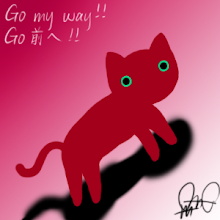1. Onomatopoeia
2. Loan words
3. Emphasized words
4. Scientific naming
5. Romanji
6. Kaomoji
Here are some examples of Japanese words found in our daily life.
1. Onomatopoeia
The sound the cats make = ニャ、ニャーァ、ニャン
The sound of knocking at the door = コツコツ
These kind of katakana words are used for simulating sounds from mother nature, animals and how objects hit for sound. There may not be any meaning when the Japanese characters are combined together.
2. Loan words
Fruit: フルーツ (in English)
Appointment: アポイントメント、アポイント、アポ(in English)
Bread: パン(in Portuguese ポルトガル)
Sometimes, we can see some katakana transcribing foreign words. Since there were not enough words in the Japanese word bank, the Japanese people tried to use these foreign words to do some expansion.
3. Emphasized words
"ゴミ" in ゴミ箱
4. Scientific naming
ゴリラ is the scientific name of gorilla.
5. Romanji
Yamaha is an international Japanese brand for musical instrument. Writing やまは in romanji is to make it common in other foreign countries and easier for foreigners to pronounce without learning Japanese characters.
6. Kaomoji
Kaomoji is the mixture of symbols, Japanese characters and kanji. People use kaomoji as a way to express their feelings in a graphical means.
eg. 。゚+.ヾ(・∀・)゚+.゚イイ!!
This kaomoji is expressing happiness. There is an inverted "A", + symbol, rotated "ッ", etc.
ボス☆やっぱりカタカナではダメみたいです~!
(http://ameblo.jp/withyuko/entry-10732167809.html)
I saw this title when I was browsing some Japanese blogs. We can see ダメ is written in katakana, which makes me ponder why katakana is used but not hiragana or kanji.
"dame" can be written in hiragana だめ, in kanji 駄目 and of course, in katakana ダメ. I guess, with different use of words, different meaning will be conveyed to the readers. If we write a sentence "私はだめです。" , the meaning of "dame" is very mild because they are in between hiragana characters. However, when we read these words, "はだめです" seems to be connected and it takes a bit time to distinguish だめ out from the word phrase. If kanji was used, the meaning may seem to be "totally not good at something" or "(machines) are not working".
Therefore, katakana can also be used to emphasis the existence of the word "dame" from the word phrase without a serious meaning. This use is to catch the readers' eyes with katakana.
Another example of use of katakana:
アニメ銀魂のED「ウォーアイニー」:
This is the 14th opening song of anime "Gintama"
We can see that the lyrics, except kanji, are all katakana.
今日、心許無シ
乙女心ハ、ユラユラ
月夜ノ我ハ泡
被害妄想、グラグラ
Another example of use of katakana:
アニメ銀魂のED「ウォーアイニー」:
This is the 14th opening song of anime "Gintama"
We can see that the lyrics, except kanji, are all katakana.
今日、心許無シ
乙女心ハ、ユラユラ
月夜ノ我ハ泡
被害妄想、グラグラ
The katakana characters in blue are of emphasizing purpose. The words can express a "lovely" feeling as the female characters do in the video.
The katakana characters in purple are the Onomatopoeia, describing the conditions.
ユラユラ is describing the status of quivering.
グラグラ is describing the status of wobbling, tottering, shaking.
色彩ノアイスクリイム
アイスクリイム is the loan word of "Ice Cream" in English.
Also, "ウォーアイニー" is the pronunciation of "I love you" (我愛你) in Putonghua. Here, the transcribing use of katakana appears again.
食事
This is a menu from a Japanese restaurant Ajisen Ramen(味千ラーメン)in Hong Kong. We can find some Japanese characters inside, I think this is to serve the Japanese customers who are living in or visiting Hong Kong.
広告
This is an advertisement of watches, the brand of which is eSwatch. It is not a Japanese brand but in this advertisement, there are Japanese sentences, writing "大切な人と、毎日もバレンタインディにしょう。あなたは、運命の人。このおもいは、一生輝きつづける。だから、忘れない。時間が流れていても、この瞬間を捕まえる。それは、永遠の愛の証明。" I guess this is the message to show the target customers that the watches aim at promoting the Japanese style and design. I think the Japanese sentences can also attract those who can understand Japanese language and impress them about the products.







